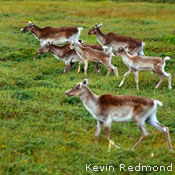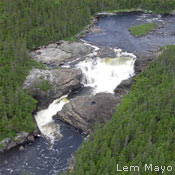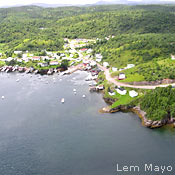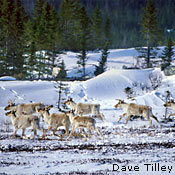- How to get there
- Activities
- Maps
- Services
- Permits
- Fees and Schedules
- Rules and Regulations
- Other Resources
The Bay du Nord River system was nominated as Newfoundland and Labrador’s second Canadian Heritage River in 1992 for its great recreational potential and magnificent natural features.
As of March, 2005, support had been overwhelming. No objections or issues were brought forward after several meetings with community leaders in Pool’s Cove, St. Albans, Conne River, and Clarenville. The final public meeting took place on March 24, 2005, in Clarenville. The designation document was presented to the Canadian Heritage Rivers Board in August, 2005 and the river was officially designated.
The information here outlines the river characteristics and management principles contained in the draft Management Plan. More information about the Bay du Nord River and its status is also available on the Canadian Heritage Rivers web site.

The Bay du Nord River flows through the pristine landscape of the Bay du Nord Wilderness Reserve, in south-central Newfoundland. It sweeps paddlers past wide barrens where caribou roam, through white-water “rattles” and quite pools where countless brook trout, landlocked salmon, and Atlantic salmon swim, and finally enters the salt waters of Fortune Bay on Newfoundland’s south coast.
The breathtaking scenery and the undisturbed wildlife and flora make this area a naturalist’s dream. The Bay du Nord Heritage River Corridor covers about 997 km2, of which about 96 percent (960 km2) falls within the Bay du Nord Wilderness Reserve and the Middle Ridge Wildlife Reserve. The two reserves guarantee the protection of the river system and will serve to preserve this river and its many features for the enjoyment of future generations.
Natural features and attributes of the Bay du Nord Heritage River that make it an excellent choice as a Canadian Heritage River include:

- its passage through the range of the Middle Ridge caribou herd, the largest caribou herd on the island of Newfoundland
- the river system runs through the Maritime Barrens ecoregion-Central Barrens subregion (1.9 MB) and the Maritime Barrens ecoregion-Southcoast Barrens subregion (1 MB) the only such representation in the Canadian Heritage River System
- the Bay du Nord flows across the Hermitage Fault, a geologic feature of international significance that marks the juncture of North America, Europe, and Africa 120 million years ago
- Mount Sylvester, the highest peak in the area, towers over a vast lake chain in the northern portion of the system
- the river has a narrow, lower-river canyon that can make the Bay du Nord rambunctious, especially at the thunderous Smokey Falls
The contrast between the quiet lake chain and the fast-flowing lower section of the river make canoeing the Bay du Nord an especially challenging and rewarding experience. Highly acclaimed, the river and its environment offer the opportunity not only for canoeing, but also for kayaking, river rafting, wilderness hiking, camping, hunting, and fishing. Access is available through several points of entry by aircraft, boat, snowmobile, or by portaging and canoeing.
Both representative and unique, the Bay du Nord River offers visitors an opportunity to experience a true wilderness adventure in the heart of Newfoundland. The protection offered by the Bay du Nord Wilderness Reserve and the Middle Ridge Wildlife Reserve enhances the wilderness character of the area. The remaining four percent of the river Corridor will be protected through a co-operative effort among resource agencies. The Bay du Nord’s admission to the Canadian Heritage Rivers System completes the process of protecting this river of national significance.
How to get there
Almost all of the Bay du Nord Heritage River Corridor is located within the Bay du Nord Wilderness Reserve and Middle Ridge Wildlife Reserve in central Newfoundland.

The four percent of the Bay du Nord outside the two reserves is all at the river’s lower extent. It is referred to here as the “Lower River Zone.” The Lower River Zone areas can be accessed by helicopter, or by taking a boat from the community of Pool’s Cove.
Services
There are few services within the Bay du Nord Heritage River Corridor, so it is important to use these guidelines when preparing for your visit:
- obtain an entry permit (for the reserves-an entry permit is not required for the Lower River Zone)
- let someone know your route and expected time of return
- travel light and leave only footprints
- carefully plan your clothing, footwear, and equipment
- take a compass and appropriate 1:50,000 topographic maps
- read and abide by the rules and regulations
Note that if you take a cell-phone, coverage will be spotty-though it is possible to make calls from some hilltops.
Permits
Bay du Nord Wilderness Reserve
In the wilderness reserve section of the Bay du Nord Heritage River Corridor, permits are required. All visitors to the wilderness reserve require an entry permit. You must obtain your permit before you enter the reserve, and carry it with you.
Application forms for the wilderness reserve entry permit are available online and at a variety of locations around the province and are usually processed within a day.
Middle Ridge Wildlife Reserve
A permit from Wildlife Division is also required for entry into the Middle Ridge Wildlife Reserve section of the Bay du Nord Heritage River. Application forms for the wildlife reserve are available by contacting the Wildlife Division. An entry permit is not required for the Lower River Zone.
Fees and Schedules
Permits are required for various activities in the reserves, but no fees are charged. Permits are not required in the Lower River Zone, outside the Bay du Nord Wilderness Reserve’s borders.
The Bay du Nord Heritage River Corridor is open year-round. However, certain activities will be greatly influenced by the season and weather conditions.
Note that snowmobiling is not permitted in the caribou winter range from December 15 to March 15. See the Bay du Nord Wilderness Reserve User’s Guide for a map of the winter range of the caribou herd.
Rules and Regulations
Wilderness conservation is one of the Province’s reserve system’s primary goals.
The following activities are strictly prohibited in the parts of the Bay du Nord Heritage River Corridor that run through the Bay du Nord Wilderness Reserve:
- introducing plants, animals, or anything else to the reserve landscape
- forestry, mining (including exploration), hydro development, agriculture, new roads, tracks, or building construction, except in the Lower River Zone where all activities are subject to existing government agencies regulations and policy
The following rules also apply when you are inside the wilderness reserve area:
- an entry permit is required, except in the Lower River Zone. You must carry your entry permit with you into the reserve.
- you must pack out everything you bring in, including cans, glass, and other refuse
- snowmobiling is not permitted in the caribou winter range from December 15 to March 15
- use of ATVs for game retrieval is not allowed in the Corridor
- during some seasons, open fires may be prohibited. Contact your local office of the Department of Natural Resources to determine if open fires are permitted. Completely extinguish fires before leaving.
- aircraft must fly above 600 m, except during take-off and landing; there are no such restrictions over the Lower River Zone
- dogs and horses are permitted, if they are kept under control at all times
- camping in one location is restricted to no more than 10 days
Official Regulations
- Wilderness and Ecological Reserves Act
- Wilderness Reserve Regulations
- Bay du Nord Wilderness Reserve Order
- Middle Ridge Wildlife Reserve Regulations
Other Resources
The following resources can help you learn more about Bay du Nord Wilderness Reserve and Canadian Heritage River.
- Bay du Nord Wilderness Reserve Management Plan
- Managing the Bay du Nord River as a Canadian Heritage River (3.8 MB)
- Maritime Barrens ecoregion-Central Barrens subregion (987 KB)
- Maritime Barrens ecoregion-Southcoast Barrens subregion (1 MB)
- Island of Newfoundland Ecoregions and Subregions (489 KB)
For more resources on Newfoundland and Labrador’s protected areas, please visit Publications and Maps.
Adobe® Acrobat® Reader software can be used for viewing PDF documents. Download Acrobat® Reader for free.
